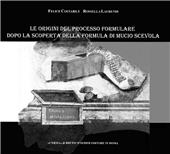Le origini del processo formulare dopo la scoperta della Formula di Mucio Scevola
104 pages
Includes bibliographical references.
The excavation of the villa in the ‘Salone' area is examined to recognize the the owners who commissioned the three main construction phases (around 150 - 40 BC). We then proceed with the analysis of the memorandum sumptuarium painted on a wall and ascertain its chronology. We therefore proceed to the evaluation of the testimonies of the primary sources and the interpretative paths from the 16th to the 21st century are examined to recognize the Augur or the Pontifex Maximus. We come to the conclusion that the Augur lived in a large domus in the urban center of Rome, while the Pontifex Maximus had a small suburban villa in the country side. This information coincides with the building characteristics of the Villa del Giurista on the Aniene and with what is written on the memorandum sumptuarium represented in a fresco: it is therefore concluded that the villa belonged to Q. Mucius Sceuola Pontifex Maximus.
At this point the question arises whether the owner of the villa in 40 BC. was the eldest son or the son of the son? [Publisher's text]
Papers presented at a conference held in Rome, Italy, September 19, 2019, already publ. in La villa del giurista sull'Aniene e i suoi affreschi (see our card. no. 5117908, EAN 9788891323750).
-
Chapters from the same volume (available individually)
-
Information
ISBN: 9788891327291
SUBJECTS HEADINGS
- Civil procedure (Roman law) -- Congresses
- Roman law -- Sources -- Congresses
- Excavations (Archaeology) -- Italy -- Aniene River Valley -- Congresses



